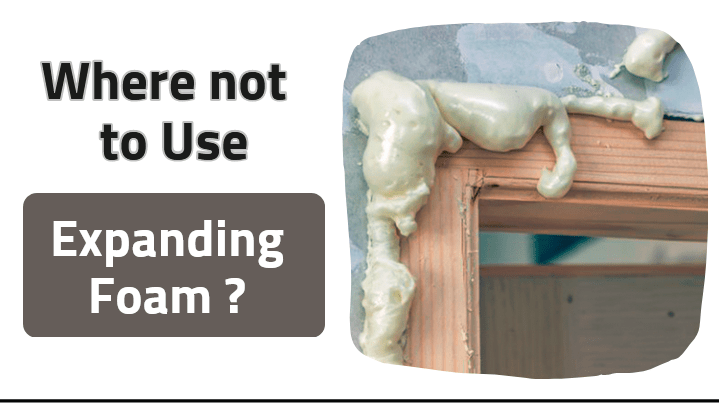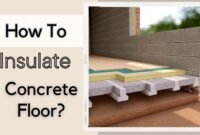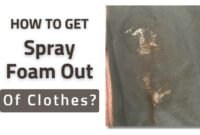Expanding foam, a type of insulation known for its high expansion properties is versatile and widely used for insulating homes, sealing gaps, and crafting. While it offers many benefits, such as reducing air leakage and enhancing indoor air quality, there are specific situations where this type of insulation is not advisable.
The reason is that it could cause damage or be ineffective for your living space. In this article, we’ll explore where not to use expanding foam, how to use it, and a guide on how to use it to fill gaps in your home effectively.
Where Not to Use Expanding Foam?
Expanding foam, also known as spray foam, is an insulation material that expands when exposed to air. It is commonly used for insulation in homes and buildings because of its ability to fill gaps and crevices. However, there are certain situations where it should be avoided, such as:

● Near Doors And Windows
Avoid using expanding foam near doors and windows. The high expansion rate of this type of insulation can cause the frames to warp, making it difficult to open and close them properly.
Instead, consider using other materials that provide a snug fit without exerting pressure on the frames. Instead, use a weatherstripping material or caulking to seal gaps around the edges.
Read also: How Do You Get Dried Expanding Foam off
● Near Electrical Boxes and Wiring
Don’t use expanding foam near electrical boxes and wiring. This type of insulation can trap heat around electric wires, potentially creating a fire hazard.
Choosing insulation materials that are safe for use around electrical components and do not contribute to heat buildup is important. Use approved electrical insulation materials instead.
● Near Fans, Ceiling Lights, or Open Flames
Also, avoid using expanding foam insulation near fans, ceiling lights, or open flames. The insulating properties of the foam, while beneficial in many scenarios, can pose a fire risk in these situations due to its flammability when exposed to high temperatures or flames. Instead, use approved fire-rated materials for these areas.
● In Areas With High Moisture
Avoid applying expanding foam in areas with high moisture levels. While some types of expanding foam offer water resistance, they can still absorb moisture over time, leading to mold and mildew growth.
It’s better to use insulation materials specifically designed to handle high-moisture environments in such areas. Use a waterproof sealant or silicone caulk instead.
● Avoid Using Closed-Cell Expanding Foam Type in Walls
Walls should not be insulated with closed-cell expanding foam because the pressure from the foam can cause the walls to bend and distort.
● Avoid Using Open-Cell Spray Foam Type On The Roof
Open-cell spray foam should be avoided on the roof as it can absorb moisture and cause the roof to deteriorate over time.
● Do Not Spray Insulation Foam As a Permanent Basement Leak Repair
Because it can retain moisture and foster the growth of mold and mildew, expanding foam is not a good choice for a long-term solution to a leaking basement.
● Avoid Using Expanding Foam As a Waterproof Barrier
Lastly, due to its lack of durability and unsuitability for this application, expanding foam should not be relied on as a waterproof barrier.
How to Use Expanding Foam
Expanding foam can be a handy tool for various DIY projects, from filling gaps and cracks in walls to insulating pipes or creating custom molds. Here’s a step-by-step guide you can try:
- Prepare your workspace and cover surfaces to avoid foam spillage.
- Shake the foam can for a minute before use to mix it well.
- Point the can and gently squeeze the trigger to fill the desired area. Apply the foam in small amounts until you get the hang of it.
- Allow the foam to cure for the time specified on the can after application. Avoid touching or disturbing the foam to prevent collapse.
- After the foam cures, trim the excess with a serrated knife or saw. Avoid cutting any underlying surfaces or structures while working with the foam.
What to Consider When Using Expanding Foam to Fill Gaps
After knowing how to use an expanding foam, here are a few things to keep in mind when using this material to fill gaps:
- Choose the suitable foam for the job according to your needs.
- Prep the area beforehand so the foam has an excellent surface to adhere to.
- Wear protective gear.
- Apply the foam carefully, and don’t overfill the gap.
- Give it time to dry.
- Trim away any excess foam once it’s dry to smooth out the area as needed.
- Use it in the appropriate place only.
Overall, it’s important to use expanding foam in the appropriate situations to ensure safety and effectiveness. If you need help with where to use expanding foam, consult a professional for advice.


